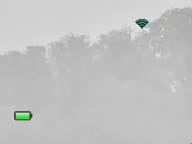How can we help?
Thermal imaging devices in the cold season: you need to know that
Anyone who has only used their thermal imaging device in summer or in dry conditions will notice by autumn at the latest that the picture quality very much from the current weather situation is dependent.
During the wet autumn air the illustrations suddenly appear significantly less detailed than one is used to. No wonder that the thought then often arises that damage could be responsible for the reduced image quality.
No defect, but physical conditions are responsible
Even if it may seem surprising at first glance, the above reduced image quality is based on the mode of operation of a thermal imaging camera. Regardless of the manufacturer, this always works with the one that is invisible to the human eye infrared radiation and processes them electronically into an image. Even minimal temperature differences of 0,10 °C are recorded and displayed in a differentiated manner.
Water molecules in the rain and fog affect the image
cold and humid air However, it significantly affects the thermal image and often leads to less detailed images. Those in the air are primarily responsible for this contained water molecules, which can obstruct the infrared radiation in places. As a result, the sensor receives less "information", which means that the images often appear in a gray haze.
Not a defect, but an image with a typical gray haze due to the ambient humidity
Many details in summer thanks to large temperature differences
In the warm months, the sun provides a very wide range at different temperature sources. Stones, bushes but also trees absorb the UV radiation of the day differently and thus make it possible wonderfully detailed thermal images with many differentiated details.
Less temperature differences - less details
In autumn and winter, cold and rain cause many objects to gradually die "same temperature" accept. At the same time, the humidity. All this leads to significantly smaller temperature differences. The result are less detailed Figures because the sensor is clear due to the weather receives less information.
This is why heat sources are mapped in detail, even in bad weather
No matter how bad the weather conditions are, usually thermal imaging cameras can heat sources yet depict very well. Even if the environment appears in the typical gray haze, that of people or animals is enough body heat given off for precise image information.
This figure shows a well-differentiated picture despite the cold ambient temperature and low humidity
Even clear nights enable a differentiated picture
However, the cold seasons do not automatically mean that the thermal image will show less detail. It is quite possible even on cold nights very precisely and detailed illustrations to obtain. However, the prerequisite for this is a night that is as clear as possible with little moisture in the air.
In this way, you can perfectly adapt the thermal image to bad weather
Even if you can't choose the weather, it's still possible, at least the image quality to optimize. The keyword is attitude. Through the targeted adaptation of Brightness and contrast usable images of the environment can be generated even under particularly poor conditions.
Conclusion: The weather makes the pictures - with every thermal imaging device
Since thermal imaging cameras work exclusively with heat, their perfect function depends very much on the meteorological conditions away. It doesn't matter whether it's an ambitious entry-level device or a professional thermal imaging camera: Physics sets clear limits here. That Adapt of brightness and contrast can help.
Reassuring: People and other heat-radiating objects will, regardless of the gray haze in bad weather, still very detailed at all times and accurately depicted. Here, a thermal imaging camera delivers usable images even under the most adverse conditions.

